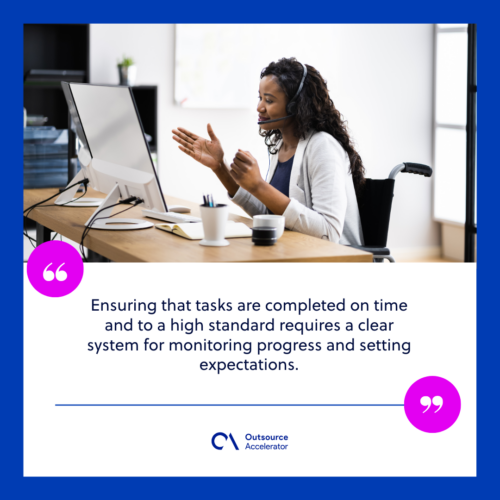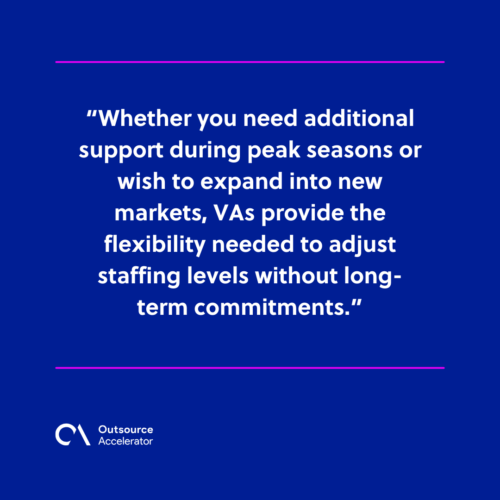Top 7 strategies for effective virtual assistant management

Hiring a virtual assistant (VA) has allowed many businesses to operate efficiently. These skilled professionals can handle administrative tasks, customer support, or specialized duties, enabling flexibility and expertise.
With more companies utilizing this approach, effective virtual assistant management is a must. However, it poses some unique challenges that require strategic methods to ensure productivity and success.
In the 512th episode of the Outsource Accelerator Podcast, Yuval Cohen, founder and CEO of VAme, shares his experience on how best to manage virtual assistants.
Challenges of virtual assistant management
Managing virtual assistants brings several hurdles, often related to the remote and independent nature of the working relationship.
Some key challenges include:
Communication barriers
The absence of face-to-face interaction can make virtual assistant management more complex. VAs may be located in different time zones, speak different languages, or have varying levels of familiarity with your business processes.
Miscommunications can lead to delays, misunderstandings, and errors in task execution.
Maintaining accountability
Since virtual assistants often work from remote locations with little direct supervision, maintaining accountability can be a challenge.
Ensuring that tasks are completed on time and to a high standard requires a clear system for monitoring progress and setting expectations.

Trust and transparency
Building trust is essential for successful virtual assistant management. However, this can be difficult to establish when team members do not meet in person.
Some businesses may struggle with concerns over data security, confidentiality, or reliability when delegating tasks to a virtual assistant.
Cultural and workstyle differences
Virtual assistants may come from diverse cultural backgrounds with different approaches to work, time management, and communication. Managing these differences requires adaptability and an understanding of how to create a collaborative environment across cultural lines.
Yuval stresses this point and recommends working with a VA managing partner.
“Always keep in mind that there’s huge cultural differences between [how] people in the US work like [versus] working with Filipinos.”
Integration with the team
If your business relies on both in-office and remote staff, integrating a virtual assistant into your team can feel disjointed.
The physical separation may prevent them from participating fully in team activities, making it harder to foster a sense of connection and shared goals.
Yuval notes that he can’t always blame some clients for getting disappointed with their VA experience after seeing unrealistic expectations online.
“I know they are exposed to something which is not healthy. They have those thoughts that it’s going to happen so fast and easily.”
7 best practices for effective virtual assistant management
To overcome these challenges and maximize the benefits of having a VA, it’s important to follow a set of best practices designed to promote clear communication, accountability, and trust.
1. Set clear expectations from the start
An important step in virtual assistant management is setting clear expectations about their roles and responsibilities. Outline specific tasks, deadlines, and quality standards in a documented agreement.
The more explicit you are, the less room there is for ambiguity. Clarifying working hours and preferred communication channels also helps avoid confusion.
Yuval finds that many smaller clients tend to overlook this and end up getting burnt out on outsourcing.
He advises people to set realistic expectations, as “sometimes it [takes] a week to find fit candidates [because] the market [and] people are changing.”
2. Leverage technology for seamless collaboration
There are dozens of online tools that will allow you to assign work to your VA. These platforms provide visibility into ongoing projects and ensure that all team members are on the same page.
For daily communication, use messaging tools for convenient options, while video platforms can be used for regular check-ins and calls.
3. Foster open and consistent communication
Virtual assistant management requires regular communication to ensure your virtual assistant stays informed and aligned with your business goals. Establish a routine for check-ins, whether it’s daily, weekly, or biweekly, depending on the nature of the tasks.
Use these check-ins to review progress, discuss challenges, and provide constructive feedback.
Encouraging an open line of communication helps your VA feel supported and allows them to ask questions or voice concerns early on.
4. Focus on building trust
Trust is the foundation of a successful working relationship with any remote worker. Be transparent about your business goals, timelines, and expectations.
Allow your virtual assistant some autonomy and empower them to make decisions within their role.
Showing confidence in their abilities can go a long way in building mutual trust. Over time, trust will also help reduce the need for constant supervision in virtual assistant management.
Yuval believes that his work is a “people game” and focuses on enriching the relationship with his employees.
“The idea is to keep the good people close so we can really provide the best service possible.”

5. Provide adequate training and resources
Even if your virtual assistant has extensive experience, it’s crucial to provide them with the training and resources necessary to understand your specific processes and systems.
Create a well-documented onboarding process that covers key aspects of your business, tools they will need, and any software or platforms they should be familiar with. This ensures they are equipped to perform their tasks effectively.
6. Monitor performance and offer feedback
Tracking your VA’s performance is essential to ensure that they are meeting your expectations. Use measurable metrics such as task completion rates, quality of work, and responsiveness to evaluate their performance.
Don’t hesitate to provide feedback—both positive and constructive—so they can improve over time. Acknowledging your VA’s achievements also boosts morale and encourages ongoing productivity.
7. Cultivate a positive work environment
Though your VA works remotely, it’s still important to foster a positive and supportive work environment. Celebrate their successes, show appreciation for their hard work, and encourage work-life balance.
As part of your virtual assistant management, make them feel valued to help increase their loyalty and job satisfaction.
Long-term benefits of strong virtual assistant management
When businesses invest in effective virtual assistant management, they can expect long-term benefits that contribute to operational success and growth.
Enhanced productivity
A well-managed virtual assistant can handle routine tasks efficiently, allowing you and your team to focus on core business activities.
With clear expectations, effective communication, and regular feedback, VAs become more productive over time and deliver high-quality results.
Yuval praises the skill of his VAs, noting their enormous potential.
“They are enabled to learn and enabled to improve, and that’s the reason why we took them.
They have this huge will to learn and you just need to overcome some obstacles, [be] a bit patient, and know what you’re doing.”
Cost efficiency
Virtual assistants typically provide flexible, scalable support. They allow businesses to save on costs associated with full-time employees, such as office space, equipment, and benefits.
With proper virtual assistant management, VAs become a cost-effective resource, ensuring tasks are completed without unnecessary overhead expenses.
Stronger business operations
By delegating administrative or specialized tasks to a virtual assistant, businesses can streamline their operations and improve overall workflow.
The time saved by offloading these responsibilities allows you to focus on growth initiatives and strategic decision-making.
Improved flexibility and scalability
A strong virtual assistant management framework allows businesses to quickly scale their workforce based on changing needs.
Whether you need additional support during peak seasons or wish to expand into new markets, VAs provide the flexibility needed to adjust staffing levels without long-term commitments.

It takes a different level of management when it comes to VAs, but Yuval reminds us that they’re more than a face on a monitor.
“There are lives behind those screens. Keep in mind that we’re always talking about people here, so treat them well.”







 Independent
Independent




